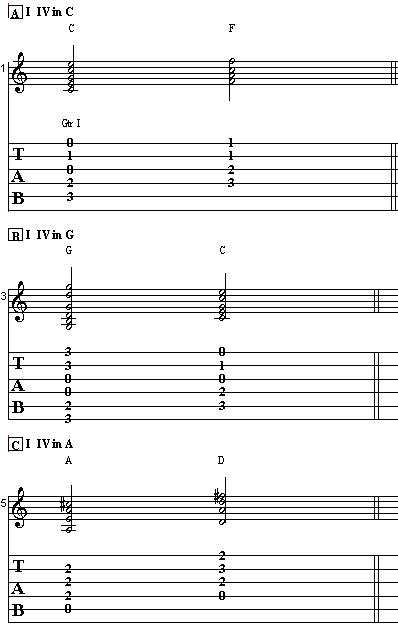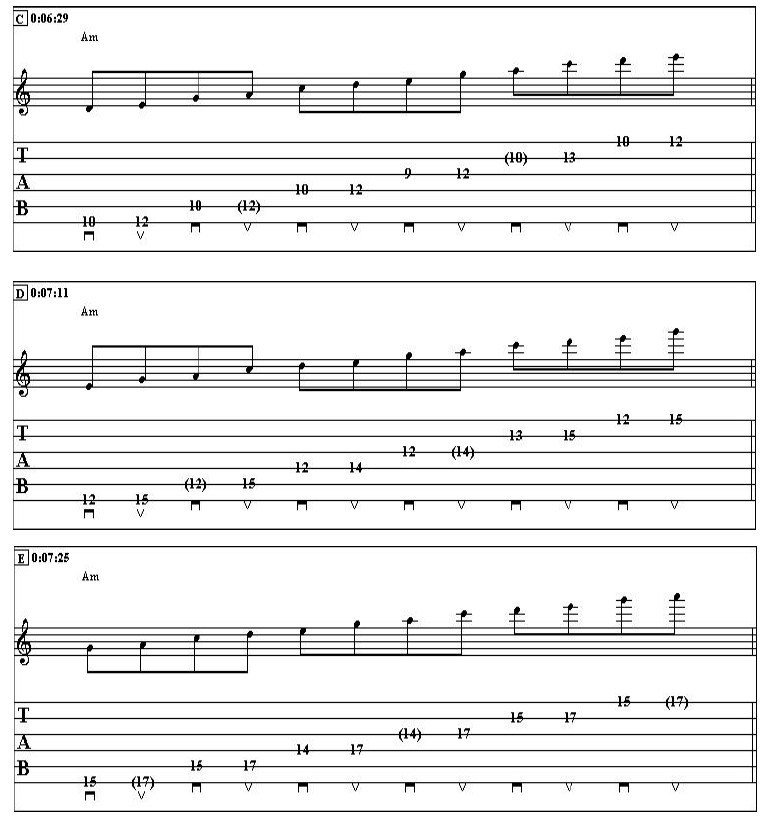A scale is a series of notes, or tones, from the chromatic scale arranged in steps to create various scales. The chromatic scale simply refers to all of the notes in western music. Below is the chromatic scale. The sharps can also be indicated as flats. For example, a C# is also a Db. This scale could theoretically be used in songwriting and guitar playing, and very often it is, but to get different sounds and make scales more manageable, we break this huge scale into major scales, minor scales, pentatonic scales, blues scales, etc. The guitar minor scale is a scale used often in blues, rock, jazz, and country playing.
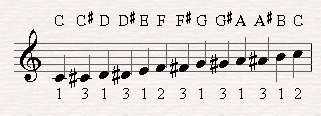 There are different types of minor scales. Relative, minor scales are easy to find. Take the key of C. The notes are C-D-E-F-G-A-B-C. The relative minor of C is A, the sixth degree of the scale. This minor scale is called the relative minor because it is relative to the key of C. Beginning on the sixth degree of any major scale and playing from that note to the octave will give you the relative minor of that major scale.
If you take the A major scale and flat the third, sixth, and seventh tones, you will arrive at the same scale. Flatting these degrees of any major scale will produce the relative, or natural minor, of the key in which you flat these notes.
Another minor scale to look at is the is the harmonic minor scale. You can find the harmonic minor by taking any natural minor scale and raising (sharping) the seventh note in the scale a half step. Raising the sixth and seventh notes of a natural minor will give you a melodic minor. Traditionally the melodic minor is used by composers when ascending and the natural minor is used when descending.
Check out this GUITAR LESSON ON SCALES
Below are examples of the minor scales. One example shows all of the natural minors. The second example shows a comparison between the minor scales. The third lays out the melodic minor scale pattern on the neck of the guitar.
There are different types of minor scales. Relative, minor scales are easy to find. Take the key of C. The notes are C-D-E-F-G-A-B-C. The relative minor of C is A, the sixth degree of the scale. This minor scale is called the relative minor because it is relative to the key of C. Beginning on the sixth degree of any major scale and playing from that note to the octave will give you the relative minor of that major scale.
If you take the A major scale and flat the third, sixth, and seventh tones, you will arrive at the same scale. Flatting these degrees of any major scale will produce the relative, or natural minor, of the key in which you flat these notes.
Another minor scale to look at is the is the harmonic minor scale. You can find the harmonic minor by taking any natural minor scale and raising (sharping) the seventh note in the scale a half step. Raising the sixth and seventh notes of a natural minor will give you a melodic minor. Traditionally the melodic minor is used by composers when ascending and the natural minor is used when descending.
Check out this GUITAR LESSON ON SCALES
Below are examples of the minor scales. One example shows all of the natural minors. The second example shows a comparison between the minor scales. The third lays out the melodic minor scale pattern on the neck of the guitar.
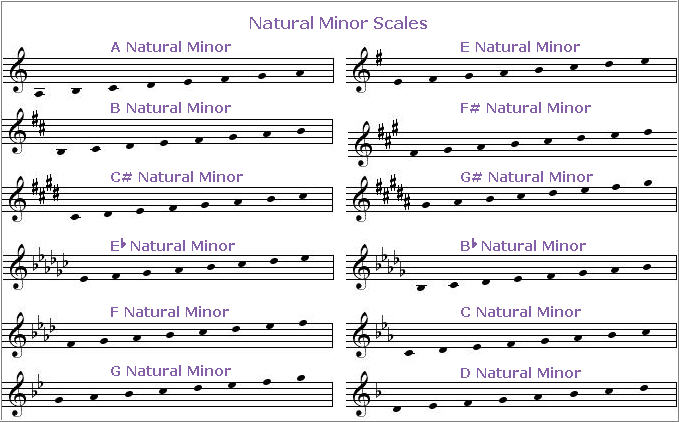
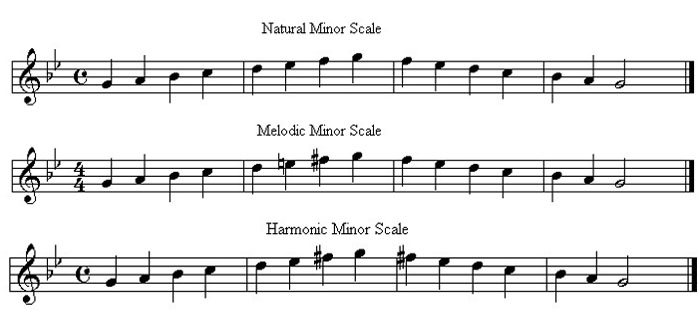
 These minor scales all have different applications, but in many cases they can be used interchangeably. The natural minor, for instance, is often used in blues. The example of the C blues scale before allows you to compare it to the C natural minor.
These minor scales all have different applications, but in many cases they can be used interchangeably. The natural minor, for instance, is often used in blues. The example of the C blues scale before allows you to compare it to the C natural minor.
 These guitar minor scales are essential for guitarists, particularly those who play blues, country, rock, and jazz. Learning them, beginning with the natural minor, will be a fundamental part of learning to play songs you love and compose your own.
If you want to get into scales and lead playing, I recommend you to check out our:
BEST SELLING LEAD GUITAR COURSE
These guitar minor scales are essential for guitarists, particularly those who play blues, country, rock, and jazz. Learning them, beginning with the natural minor, will be a fundamental part of learning to play songs you love and compose your own.
If you want to get into scales and lead playing, I recommend you to check out our:
BEST SELLING LEAD GUITAR COURSE
 There are different types of minor scales. Relative, minor scales are easy to find. Take the key of C. The notes are C-D-E-F-G-A-B-C. The relative minor of C is A, the sixth degree of the scale. This minor scale is called the relative minor because it is relative to the key of C. Beginning on the sixth degree of any major scale and playing from that note to the octave will give you the relative minor of that major scale.
If you take the A major scale and flat the third, sixth, and seventh tones, you will arrive at the same scale. Flatting these degrees of any major scale will produce the relative, or natural minor, of the key in which you flat these notes.
Another minor scale to look at is the is the harmonic minor scale. You can find the harmonic minor by taking any natural minor scale and raising (sharping) the seventh note in the scale a half step. Raising the sixth and seventh notes of a natural minor will give you a melodic minor. Traditionally the melodic minor is used by composers when ascending and the natural minor is used when descending.
Check out this GUITAR LESSON ON SCALES
Below are examples of the minor scales. One example shows all of the natural minors. The second example shows a comparison between the minor scales. The third lays out the melodic minor scale pattern on the neck of the guitar.
There are different types of minor scales. Relative, minor scales are easy to find. Take the key of C. The notes are C-D-E-F-G-A-B-C. The relative minor of C is A, the sixth degree of the scale. This minor scale is called the relative minor because it is relative to the key of C. Beginning on the sixth degree of any major scale and playing from that note to the octave will give you the relative minor of that major scale.
If you take the A major scale and flat the third, sixth, and seventh tones, you will arrive at the same scale. Flatting these degrees of any major scale will produce the relative, or natural minor, of the key in which you flat these notes.
Another minor scale to look at is the is the harmonic minor scale. You can find the harmonic minor by taking any natural minor scale and raising (sharping) the seventh note in the scale a half step. Raising the sixth and seventh notes of a natural minor will give you a melodic minor. Traditionally the melodic minor is used by composers when ascending and the natural minor is used when descending.
Check out this GUITAR LESSON ON SCALES
Below are examples of the minor scales. One example shows all of the natural minors. The second example shows a comparison between the minor scales. The third lays out the melodic minor scale pattern on the neck of the guitar.
Guitar Minor Scale


 These minor scales all have different applications, but in many cases they can be used interchangeably. The natural minor, for instance, is often used in blues. The example of the C blues scale before allows you to compare it to the C natural minor.
These minor scales all have different applications, but in many cases they can be used interchangeably. The natural minor, for instance, is often used in blues. The example of the C blues scale before allows you to compare it to the C natural minor.
 These guitar minor scales are essential for guitarists, particularly those who play blues, country, rock, and jazz. Learning them, beginning with the natural minor, will be a fundamental part of learning to play songs you love and compose your own.
If you want to get into scales and lead playing, I recommend you to check out our:
BEST SELLING LEAD GUITAR COURSE
These guitar minor scales are essential for guitarists, particularly those who play blues, country, rock, and jazz. Learning them, beginning with the natural minor, will be a fundamental part of learning to play songs you love and compose your own.
If you want to get into scales and lead playing, I recommend you to check out our:
BEST SELLING LEAD GUITAR COURSE 